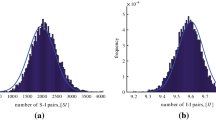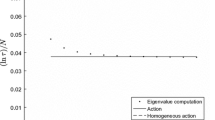Abstract
We consider an epidemic model of SIR type set on a homogeneous tree and investigate the spreading properties of the epidemic as a function of the degree of the tree, the intrinsic basic reproduction number and the strength of the interactions between the populations of infected individuals at each node. When the degree is one, the homogeneous tree is nothing but the standard lattice on the integers and our model reduces to a SIR model with discrete diffusion for which the spreading properties are very similar to the continuous case. On the other hand, when the degree is larger than two, we observe some new features in the spreading properties. Most notably, there exists a critical value of the strength of interactions above which spreading of the epidemic in the tree is no longer possible.






Similar content being viewed by others
Notes
Note that in the physics literature homogeneous trees of degree k are often called Bethe lattices (Bethe 1935).
References
Aronson DG (1977) The asymptotic speed of propagation of a simple epidemic. Res Notes Math 14:1–23
Ball F, Britton T (2020) Epidemics on networks with preventive rewiring. arXiv:2008.06375
Berestycki H, Nordmann S, Rossi L (2020) Modeling propagation of epidemics, social unrest and other collective behaviors. arXiv:2005.09865
Berestycki H, Roquejoffre J-M, Rossi L (2021) Propagation of epidemics along lines with fast diffusion. Bull Math Biol 83(1):1–34
Besse C, Faye G (2021) Dynamics of epidemic spreading on connected graphs. J Math Biol 82(6):1–52
Bethe HA (1935) Statistical theory of superlattices. Proc R Soc Lond A 150(871):552–575
Bollobás B (2013) Modern graph theory, vol 184. Springer, Berlin
Bonnasse-Gahot L, Depuiset M-A, Gordon MB, Roché S, Rodriguez N, Nadal JP (2005) Epidemiological modelling of the French riots: a spreading wave and the role of contagion. Sci Rep 8:2018
Britton T, Deijfen M, Lindholm M, Nordvall Lageras A (2008) Epidemics on random graphs with tunable clustering. J Appl Prob 45:743–756
Brockmann D, Helbing D (2013) The hidden geometry of complex, network-driven contagion phenomena. Science 342(6164):1337–1342
Burioni R, Chibbaro S, Vergni D, Vulpiani A (2012) Reaction spreading on graphs. Phys Rev E 86(5):055101
Chen X (1997) Existence, uniqueness, and asymptotic stability of traveling waves in nonlocal evolution equations. Adv Differ Equ 2(1):125–160
Chen X, Guo JS (2002) Existence and asymptotic stability of traveling waves of discrete quasilinear monostable equations. J Differ Equ 184:549–569
Chen X, Fu S-C, Guo JS (2006) Uniqueness and asymptotics of traveling waves of monostable dynamics on lattices. SIAM J Math Anal 38(1):233–258
Chen YY, Guo JS, Hamel F (2017) Traveling waves for a lattice dynamical system arising in a diffusive endemic model. Nonlinearity 30(6):2334
Chen LM, Holzer M, Shapiro A (2018) Estimating epidemic arrival times using linear spreading theory. Chaos Interdiscip J Nonlinear Sci 28(1):013105
Corless RM, Gonnet GH, Hare DE, Jeffrey DJ, Knuth DE (1996) On the LambertW function. Adv Comput Math 5(1):329–359
Diekmann O, Heesterbeek JAP, Metz JAJ (1990) On the definition and the computation of the basic reproduction ratio \(R0\) in models for infectious diseases in heterogeneous populations. J Math Biol 28:365
Ducrot A, Giletti T (2014) Convergence to a pulsating travelling wave for an epidemic reaction–diffusion system with non-diffusive susceptible population. J Math Biol 69(3):533–552
Fu SC, Guo JS, Wu C-C (2016) Traveling wave solutions for a discrete diffusive epidemic model. J Nonlinear Convex Anal 17:1739–1751
Hethcote HW (2000) The mathematics of infectious diseases. SIAM Rev 42(4):599–653
Hindes J, Singh S, Myers CR, Schneider DJ (2013) Epidemic fronts in complex networks with metapopulation structure. Phys Rev E 88(1):012809
Hoffman A, Holzer M (2019) Invasion fronts on graphs: the Fisher-KPP equation on homogeneous trees and Erdös–Réyni graphs. Discrete Contin Dyn Syst B 24(2):671
Kermack WO, McKendrick AG (1927) A contribution to the mathematical theory of epidemics. Proc R Soc Ser A 115:700–721
Matano H, Punzo F, Tesei A (2015) Front propagation for nonlinear diffusion equations on the hyperbolic space. J Eur Math Soc 17(5):1199–1227
Sahneh FD, Scoglio C, Van Mieghem P (2013) Generalized epidemic mean-field model for spreading processes over multilayer complex networks. IEEE/ACM Trans Netw 21(5):1609–1620
Spricer K, Britton T (2019) An SIR epidemic on a weighted network. Netw Sci 7:556–580
Stolerman LM, Coombs D, Boatto S (2015) SIR-network model and its application to dengue fever. SIAM J Appl Math 75(6):2581–2609
Van den Driessche P, Watmough J (2002) Reproduction numbers and sub-threshold endemic equilibria for compartmental models of disease transmission. Math Biosci 180(1–2):29–48
Weinberger H (1982) Long-time behavior of a class of biological models. SIAM J Math Anal 13(3):353–396
Wu C-C (2017) Existence of traveling waves with the critical speed for a discrete diffusive epidemic model. J Differ Equ 262(1):272–282
Zinner B, Harris G, Hudson W (1991) Traveling wavefronts for the discrete Fisher’s equation. J Differ Equ 105:46–62
Acknowledgements
This work was partially supported by Labex CIMI under grant agreement ANR-11-LABX-0040. G.F. acknowledges support from an ANITI (Artificial and Natural Intelligence Toulouse Institute) Research Chair.
Author information
Authors and Affiliations
Corresponding author
Additional information
Publisher's Note
Springer Nature remains neutral with regard to jurisdictional claims in published maps and institutional affiliations.
Rights and permissions
About this article
Cite this article
Besse, C., Faye, G. Spreading Properties for SIR Models on Homogeneous Trees. Bull Math Biol 83, 114 (2021). https://doi.org/10.1007/s11538-021-00948-7
Received:
Accepted:
Published:
DOI: https://doi.org/10.1007/s11538-021-00948-7




